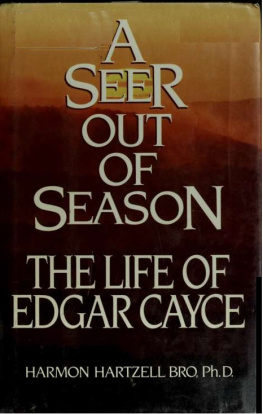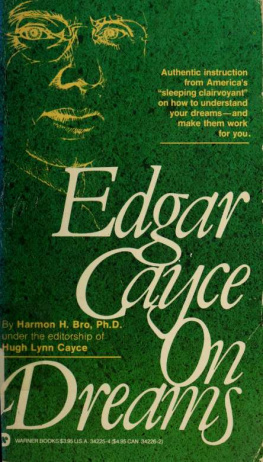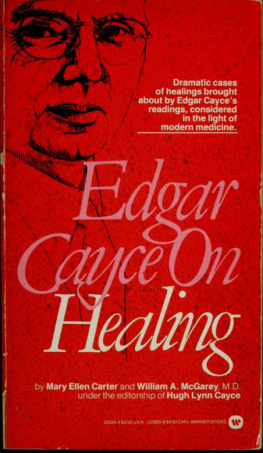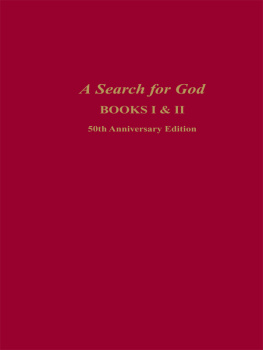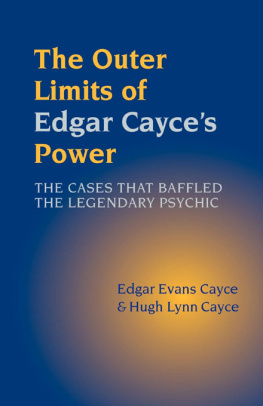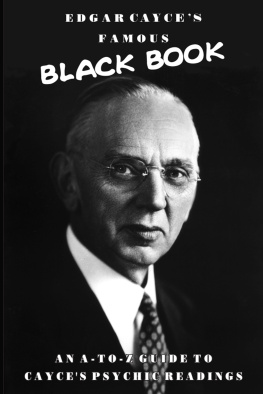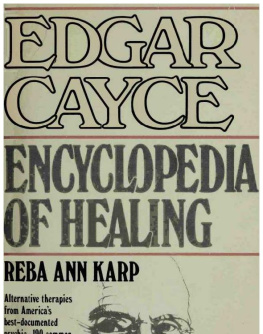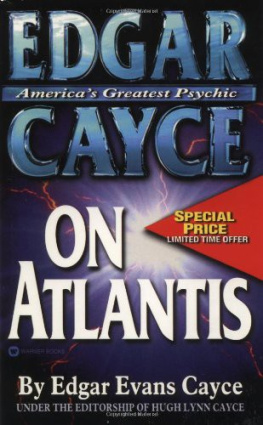Copyright
1989 by Harmon Hartzell Bro
All rights reserved. For Information address New American Library.
Published simultaneously in Canada by Penguin Books Canada Limited.NAL BOOKS TRADEMARK REG. U.S PAT. OFF. AND FOREIGN COUNTRIES REGISTERED TRADEMARKMARCA REGISTRADA HECHO EN DRESDEN, TN
Signet, Signet Classic, Mentor, Onyx, Plume, Meridianand NAL Books are published in the United States by NAL PENGUIN INC.,
1633 Broadway, New York, New York 10019,
in Canada by Penguin Books Canada Limited,
2801 John Street, Markham, Ontario L3R 1B4
Designed by Julian Hamer
Library of Congress Cataloging-in-Publication Data
Bro, Harmon Hartzell, 1919
A seer out of season : the life of Edgar Cayce / Harmon Hartzell Bro. p. cm.
ISBN 0-453-00625-6 1. Cayce, Edgar, 1877-1945.
Biography. I. Title.
BF1027.C3B73 1988 133.8'092'4dc 19
88-22704
CIP
To my graduate students, who for nearly half a century have taught me so much with their questions and creations, and to those bold graduate students of the next half century who will try to figure out where seers and open vision belong in our culture.
Acknowledgments
Nobody has contributed more to this book than Hugh Lynn Cayce, the elder son of Edgar Cayce. In 1945, and again in 1950, while memories of his father were still fresh for both of us, I took six months off from teaching to interview scores of people who knew Cayce well, and to pursue themes with Hugh Lynn. The task then was completing my doctoral dissertation on Cayce for the University of Chicago. Over the years that followed we spoke often and deeply about his father, as we worked together on projects of writing, lecturing, and teaching. Before his death in 1982 he came repeatedly to see me in Chicago, where I had begun work on this biography. He reviewed with care each draft, and the results are here, although the interpretive categories and conclusions are mine. I wish to acknowledge with gratitude also the aid of the faculty of Harvard Divinity School and Harvard's Center for the Study of World Religions, who enabled me to study perspectives helpful for understanding Cayce during two separate periods as a Visiting Scholar, and a grant for part of that study from the Irving F. Laucks Foundation of Santa Barbara, California. The University of the Pacific at Stockton, California, gave me an opportunity to relate parapsychology to faith life, by inviting me to give the Colliver Lectures on "Spirituality in a Psychological Age."
Contents
Acknowledgments
Preface
Part I:
The Gift: Love Surprised by Wisdom
1.I Dont Do Anything You Cant Do
2.Mr. Cayce, I Am Dying
3.When I Am Absent from the Body
4.No Disease Without a Cure
5.In Those Days There Was No OpenVision
6.Friends, I Have Nothing to Sell
7.Such a Life Is Not Easy
8.If This Is True, Why Havent I Heard of It?
Part II:
The Roots: Cayce Before Cayce
9.We Are Living Several Lives at Once
10.High Priest and Scoundrel, Warrior and Shepherd of Souls
Part III:
The Life: Wrestling Through the Dawn
11.Rely on the Promise
12.It Should Be Thoroughly Tested
13.Why Shouldnt I Dread Publicity?
14.Untouched Oil Pools in Texas
15.The Great Influential Institution
16.There Is Nothing New Here
17.Ask That the Life of Cayce Be Spared
REFERENCES
CHRONOLOGY OF THE LIFE OF EDGAR CAYCE
SELECTED BIBLIOGRAPHY
A
SEER
OUT OF
SEASON
THE LIFE OF EDGAR CAYCE
Preface
The life of Edgar Cayce is surely one of the most challenging and appealing adventure stories of modern times.
It is first of all an adventure of uncommercialized and unpublicized medical service, given to thousands of sufferers from intractable illnesses, crippling injuries, and sad birth defects. For over forty years they turned to him from locations around the world for aid to their physicians and guidance to themselvesand to an astonishing degree found it, although Cayce was not medically trained in any way.
He was not a faith healer, for he could not affect wounded bodies by touch or speech. Yet by a process which he felt was an answer to the prayerful longings of his youth, he provided careful and sophisticated diagnoses, often using technical terms and clinical data. He also recommended complex and at times remarkably original treatment measures, and swiftly located available experts, medications, or specialized treatment centers for those in pain to use. Year after year, decade after decade, he was a one-man clinic for hopeless cases, though utterly dependent on physicians and hospitals and patients to achieve the results he saw as possible.
Not to glimpse him first of all struggling over the broken and dying, the mentally disoriented, the harshly retarded, is to miss him where he lived, and to miss the rest of his story as well. For his tender and unflagging caring for one desperate person at a time was the seal of his labors, which must be broken open to grasp what he did and what it means for others of us, peering at him in no little doubt and wonder. Cayce's life is essentially a story of compassion in action.
To get him in view, we need to recall other medical servants whose efforts stir even media-jaded moderns, when we see that they were unwilling to exploit their talents for money or fame or power. Father Damien working with outcast Hawaiian lepers, Leeuwenhoek staring at microbes in the microscope he has just invented, Pasteur trying to prevent ravaging disease, Schweitzer offering medical care in the African jungleall of these lift our spirits in our common human journey to nobility and generosity together. Beside them we can see others who are first of all helpers of the wounded and threatened, groping their way to fresh solutions: Gandhi cleaning toilets with the outcastes in India, King marching with throngs of left-out American blacks, Jane Addams creating settlement houses in the slums. Mother Teresa clasping the poor and dying. Not to locate Cayce among the idealists who are also dogged activists in their labors is to start down the wrong road to understanding him and helping to duplicate his service.
Yet in our quick-fix engineering culture, we paste on Cayce the label of "psychic" and promptly lose him.
For the second adventure in the life of Cayce is an exploration into capacities for knowing that must startle and puzzle any thoughtful inquirer. His story inevitably becomes the story of the rest of us, living in the same universe but by comparison groggily asleep.
He was indeed psychic in dependable modes that make him the best-documented example of such capacities in Western history. There are over fourteen thousand files of cases he served with his unusual ability that began in 1901 (just when Freud was publishing his epochal The Interpretation of Dreams, and William James was giving his penetrating lectures for The Varieties of Religious Experience). Cayce typically did his work in a self-induced, prayer-related trance, examining and prescribing for subjects who were often absent by hundreds and thousands of miles, and whom he had usually never met. Yet to call him a psychic is to call an opera star an athlete of the vocal cords. For Cayce's aid was not simply raw data dumped on frantic seekers, but carefully devised counsel as fraught with values as with information. He spoke not only of organs and tissues and interventions, but of justice and love, and of beauty and holiness, as the context for healing and wholeness. Only a time so impotent for personal and social goodness that it must seize on powers ahead of meaning would be satisfied with labeling him a clairvoyant. To find his visionary yet practical gift, one must remember Judaism's Baal Shem Tob combining healing with mystical vistas, Melville viewing the world from the bowels of whales, Blake painting fiery creation, Freud finding darkness and light through sexuality, and Jung glimpsing with Plato the starry heavens of archetypes within human deeps.

